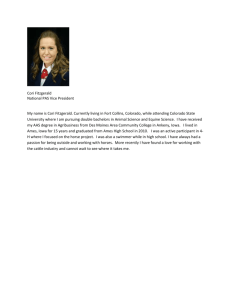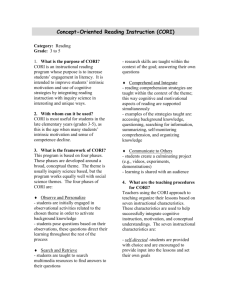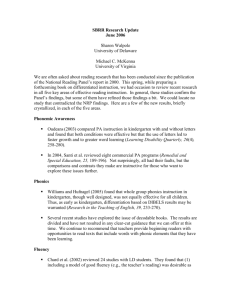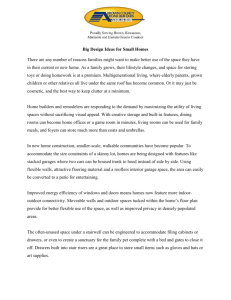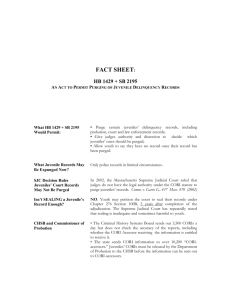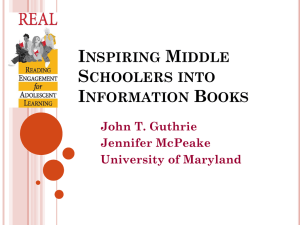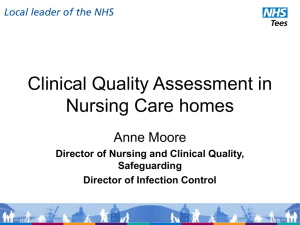BDO presentation template
advertisement
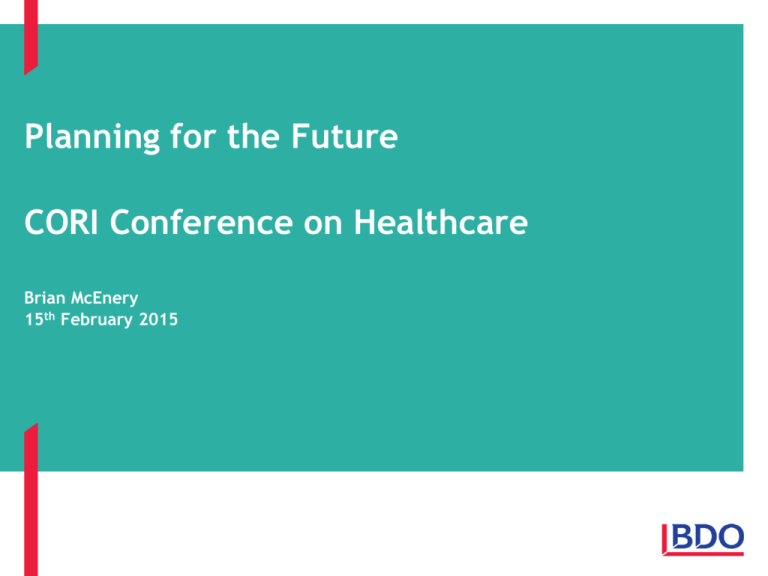
Planning for the Future CORI Conference on Healthcare Brian McEnery 15th February 2015 Contents • • • • • • • • About BDO Healthcare Health’s Ageing Crisis Report Facing the Challenges Mapping a sustainable solution Nursing Homes Ireland Survey 2015 Trends in the Sector Governance & Culture HIQA – its methodologies and focus CORI - Planning for the Future Page 2 BDO Healthcare ABOUT BDO Ireland 3 Three offices across the country 500+ Over 500 partners & staff 1st World’s largest European led accountancy network 1,328 Offices in over 151 countries 60,000 Almost 60,000 Partners and staff world wide ABOUT BDO Our Healthcare Team Banks & Lending Institutions • The National Nursing Home Survey – In association with Bank of Ireland & NHI, BDO is once again carrying out an in depth survey of private & voluntary homes to identify the key issues impacting on the industry at present. • Health’s Aging Crisis – Commissioned by NHI this report comprised an analysis of the supply and demand factors at play in the nursing home industry. Department of Finance / Revenue Private Investors & EIIS Funds HSE/ Department of Health • Cost of Care Report – In association with Age Action Ireland the firm conducted a detailed analysis of the costs associated with the provision of older person care in order to arrive at a ‘fair price’ for long term residential care. Construction Industry Older Person Care National Treatment Purchase Fund HIQA Nursing Home Operators 5 Age Action Ireland Some of the bodies we interact with frequently.. CORI - Planning for the Future Page 6 Working with the Voluntary Sector • • • • • As a firm we work with about 15 Congregations Great privilege to do so – good clients Work of the Congregations has been invaluable to Irish Society for decades and longer So every Congressional need is different, therefore we offer: Strategic reviews – route to better outcomes – find solutions not problems! Operational reviews – benchmarking – often labour related Income negotiation – NTPF negotiations Banking financial and commercial advices e.g. accessing philanthropy Budgeting, accounting, audit and financial management Asset management & advisory CORI - Planning for the Future Page 7 “Health’s Ageing Crisis” BDO Report A MARKET IN FLUX Funding & Fair Deal Regulation Demand (Need) Supply Policy CORI - Planning for the Future Page 9 • Fair Deal Review • Sustainability of Scheme in Current Format • Variance in rate and lack of transparency • Process of negotiating the rate- no negotiation of public FDR • Accessibility to development capital and funding • HIQA • Physical Environment Deadline (July 2015) • Focus on risk based regulation • A growing and ageing population • Growth in the older old • Changing levels of dependency & acuity • Low levels of new supply entering the market • Equity Gap • Shrinking capacity in public and voluntary sector • Objective of Government to provide more care in the community • Continue to provide 20% overall bed provision • 4.5% of over 65+ population in residential care not sustainable DEMOGRAPHICS – KEY NUMBERS - KEY CHALLENGES Age 2011 2021 % Growth (2011-2021) 2031 2041 2046 % Growth (2011-2046) 65-69 172.1 225.6 31% 281.2 333.2 354.6 106% 70-74 130.1 191.6 47% 238.3 291.1 318.7 145% 75-79 101.4 139.5 38% 192.1 245.6 269.3 166% 80-84 69.8 90.1 29% 143.9 187.4 213.8 206% 85+ 58.2 85.0 46% 135.5 219.0 262.9 352% Total 65+ 531.69 731.9 38% 991.0 1,276.3 1,419.3 167% % of Pop 11.6% 14.9% 18.7% 22.4% 24% 4.5% 23,920 32,930 44,590 57,430 63,870 Source: CSO Census of Population 2006 + 2011 & Population and Labour Force Projections 2016-2046 CORI - Planning for the Future Page 10 DEMOGRAPHICS – AN AGEING POPULATION Aged Population Growth & Split by Age • Across all 65+ cohort, population to grow from • 2011 - 11.6% population • 2046 – 24% population 1,600,000 1,400,000 1,200,000 1,000,000 • 65+ population to grow • 2011-2021 + 38% • 2011-2046 + 167% 800,000 600,000 • 85+ to grow • 2011-2021 +46% • 2011-2046 +352% 400,000 200,000 0 2011 2012 2013 2014 2015 2016 2017 2018 2019 2020 2021 2026 2031 2036 2041 2046 65-69 70-74 75-79 80-84 85+ Source: CSO Census of Population 2006 + 2011 & Population and Labour Force Projections 2016-2046 CORI - Planning for the Future Page 11 BRINGING IT TOGETHER – DEMAND (NEED) > SUPPLY Projections - Bed Demand (Need) v's Supply 40,000 38,000 36,000 34,000 Beds 32,000 30,000 28,000 26,000 24,000 22,000 20,000 • • Demand for Beds 2012 26,566 2013 27,415 2014 28,293 2015 29,201 2016 30,139 2017 31,250 2018 32,405 2019 33,603 2020 34,847 2021 36,138 Supply Scenario 1 24,668 24,886 25,158 25,488 25,931 26,386 26,816 27,249 27,684 28,152 Supply : Scenario 2 24,668 24,668 24,540 24,411 24,380 24,467 24,593 24,785 25,005 25,225 Supply: Scenario 3 24,668 24,977 25,442 25,966 26,608 27,310 27,987 28,669 29,356 30,080 For the purposes of our analysis, we have equated demographic and disability driven NEED for Beds as being equivalent to actual DEMAND for beds. In practice, actual Demand for beds, as manifested by residents and waiting lists may be moderated by factors other than need - such as affordability and geographic location CORI - Planning for the Future Page 13 BRINGING IT TOGETHER – THE RESULTING SHORTFALL Axis Title Projected Shortfall - Bed Demand v's Bed Supply 14,000 13,000 12,000 11,000 10,000 9,000 8,000 7,000 6,000 5,000 4,000 3,000 2,000 1,000 0 2012 2013 2014 2015 2016 2017 2018 2019 2020 2021 Scenario 1 1,898 2,530 3,135 3,713 4,208 4,864 5,588 6,354 7,162 7,986 Scenario 2 1,898 2,747 3,753 4,790 5,759 6,784 7,812 8,818 9,842 10,913 Scenario 3 1,898 2,439 2,851 3,235 3,531 3,941 4,417 4,933 5,490 6,058 “To maintain current provision and address current capacity issues – requirement of €834m”- Action Plan – Public Residential Care 2013 - 2023 CORI - Planning for the Future Page 14 • Assumptions • Based on Likely Scenario • Based on no reduction past 4.5% • Based on Av home size of 80 beds • Private: • Bed additions : adds net 3,051 by 2021 • New Homes – equivalent to 38 new homes • Public • Bed additions : net additions nil • Focus on having existing stock HIQA compliant • Voluntary • Bed additions : reduction 400 • New Homes – equivalent to loss 5 homes • NET Remaining Shortfall • Significant growth in shortfall 2011-2021 • 2012 – 1,898 - equivalent to 24 homes • 2021 – 7,986 – equivalent to 100 homes Meeting Challenges ‘Head On’ Income and expenditure relationship CORI - Planning for the Future Page 16 The Mission in Ireland • • • • • • • • For many Congregations the Mission in Ireland is becoming hard to fulfil This can be both a physical and emotional weight on the Congregation For sure vocational decline is disappointing but….. Its important to recognise and have recognised the value of the Religious contribution when Irish Society most needed it in health, education It should be a celebration of this rather than mourning lesser input going forward For many Congregations their strength is in lesser developed countries and these regions need healthcare, educational and pastoral support even more than Ireland For many Congregations the process of supplementary lay support is well underway to ensure the Mission also continues in Ireland There are many ways to ensure the Mission endures! CORI - Planning for the Future Page 17 Optimal care setting – dependency based Increases in dependency CORI - Planning for the Future Page 18 Healthcare Solutions Healthcare Mission Other Mission e.g. education Objective CORI - Planning for the Future Page 19 • Ensure Mission continues • Ensure care solutions exist for Congregation • Partnership for care • Procurement solutions • Good care solutions • Pastoral needs met Where there is a healthcare Mission Laicisation Professionally & Governance Continued operation Partnership Joint ventures / Management contracts Health & Social Care Disposal Sale and reuse of resources In all instances care of the Congressional members can be central to the solution CORI - Planning for the Future Page 20 Issues to consider Investment Action Plan Overall plan for Congregation CORI - Planning for the Future Page 21 More non Religious input Future Governance structures Ageing facilities, poor Fair Deal rates & Sec 39 CORI - Planning for the Future Page 22 For some Congregations…. Sec 39 As • • • • • • • • • part of our strategic reviews we have: Determined the true cost of care, having Factored in the likely re-development cost Worked in interest & capital repayments Included the impact of HRA reversals Frankly determined the rate per resident per week is not near adequate Difficult but necessary discussions with NTPF to get an appropriate rate Section 39 was a last minute inclusion in 2009 and is UNFAIR Big issue for the some of Religious in care provision Needs to be addressed and we have got some acknowledgement of the issue CORI - Planning for the Future Page 23 Ageing Congregations & State Supports • • • • • • • Medical Cards Drug Payment Scheme (DPS) Homecare Packages Carer’s benefit Tax refund (Med 1) Age tax credit Community Care Services CORI - Planning for the Future Page 24 The Fair Deal Financial Needs Assessment Medical Needs Assessment Financial needs assessment should be satisfactory If medical needs are of a scale requiring long term care Then 80% of pension contributed to care Care has to be exercised for dedicated Congressional Homes that they qualify under the NHSS – need to be seen as generally accessible • This has been a very positive scheme for the Religious • • • • • • CORI - Planning for the Future Page 25 Living in Community • • • • • • • Care often provided within the community Assisted Living Solutions – very satisfactory for the Congregation and the resident Important to have proper staffing and supports particularly with high dependency With lower Congressional staffing – external employees will be more involved This brings a need for staffing processes, employment law responsibilities, health & safety legislation These facilities can fall to be registered by HIQA – Decision of the Chief Inspector In many instances settings which were not registered and now requiring registration CORI - Planning for the Future Page 26 Ensuring that the Mission Lives On • Diminishing numbers of members in recent years has lead to an increased lay involvement in the day to day operations of many Congregations whether that be Education, Care of the Elderly, Social Services etc. • As a result many Orders are seeking to put in place appropriate structures and governance systems to ensure that there is an organisation capable of continuing the Mission even if the Congregation no longer has a day-to-day involvement • These structures and governance are particularly important in light of the requirements of the Charities Act 2009 • This is not a straightforward process as it may involve the transfer of assets and the setting up of charitable companies • In some cases the operations of the Congregation may be significantly loss making and reliant on donations – sustainable solutions need to be plotted • In an environment of diminishing donations it may be necessary to review the operating model to ensure that it is possible to continue to carry out the Mission on a sustainable basis into the future CORI - Planning for the Future Page 27 Solutions need to be tailored to the needs • No one solution meets the needs of every Congregation • Solutions need to be tailor made • Invariably good outcomes evolve • Dealing with the issues early is important CORI - Planning for the Future Page 28 Mapping a Path to a Sustainable Future Securing the Mission for Future Generations • Until recently the operations of Religious Orders in Ireland were carried out under the almost exclusive stewardship of the members of that Order • In recent years due to declining numbers it has been necessary to involve lay people in this stewardship function • The Catholic Church has recognised ‘Ministerial Juristic Persons’ in which laity can join with religious/clergy to carry out the role and responsibility of sponsorship of a Mission • There is an intersection of Cannon Law, Company Law and in recent years the Charities Act • The process is undoubtedly complex but with the right supports and advice it is possible to put in place the appropriate structures and governance to continue the mission long into the future CORI - Planning for the Future Page 30 A Sustainable Business Model • In the past many of the operations carried out by Religious Orders in Ireland have been subsidised by large donations and state funding • In recent years both sources have diminished and there are increasing pressures to carry on operations on a more commercial basis • Clearly, the main focus is not to generate a profit, however, it is important to generate sufficient return to reinvest in the Mission for the future • BDO has worked with a number of religious nursing home operators to ensure that their nursing homes will be capable of continuing operating many years into the future • This has included, NTPF negotiations, strategic reviews of operations and assistance with development and expansion • In many cases this is not an easy process, however, it is possible to travel the journey from a precarious financial position to a long term sustainable future • Sometimes the organs of state took advantage of the voluntary sector and this has led to a lack of reserves for capital investment CORI - Planning for the Future Page 31 Alternative Options • In some cases the Order may take the decision that they no longer wish to have control of their nursing home or other operation • However, they do not wish to see their Mission come to an end • It is possible to ensure that the Mission be continued outside the control of the Order by a similarly minded organisation • Taking nursing homes as an example; it may be possible to sell or lease the home to an operator with a compatible vision and approach to care provision • BDO have assisted in a number of these transactions also • It is important for the Order to be clear on their required covenants around continuing use for care purposes or priority of access for members of the Congregation • Any transfer of asset by a charitable organisation must be approved by the Charities Regulatory Authority CORI - Planning for the Future Page 32 Nursing Homes Ireland – Industry Survey Survey 2014/2015 NHI Survey 2015 - authored by BDO • Survey sponsored by Bank of Ireland, BDO and Homecare Medical Supplies Survey secured responses from over one third of operators Very detailed questionnaire Useful for benchmarking purposes Gives an overall sense of the sector Survey was welcomed and launched by Minister Lynch Minister spoke of public finance challenges Congratulated the private and voluntary sector for their development Spoke of challenges in meeting the deadlines for physical environment Standard 25 Government is studying incentives to encourage private sector investment • • • • • • • • • 34 Some Important Numbers 2003 2004 2005 2006 2007 2009 2014 Rate €557 €578 €640 €694 €778 €850 €896 Beds 14,946 16,461 17,722 17,909 18,883 20,590 22,342 Homes 408 427 431 433 435 447 437 Wage % 56% 56% 57% 60% 60% 62% 61.5% HSE beds 32% 41% 30% 28% 32% 9% 21% 24% 29% 22% 20% 42% More beds 42% Key Stats • Rate is the average national rate across the country i.e. €896 per resident per week • The trend of larger homes continues in this survey i.e. more beds & fewer homes • Wages as a percentage of turnover stays at about 62% • The incidence of directly funded HSE beds continues to fall - just 9% now • Operators demonstrate a growing appetite to further develop their existing or new homes 35 Opening Numbers (Cont) • The average national Fair Deal rate has increased by 5% since 2009/2010 (a five year period) - i.e. during the financial crisis • Overall bed numbers have increased by approximately 8.5% or 350 beds per year • This occurred during a time when the total number of private & voluntary homes has reduced by 10 homes • The average home size is now 51 beds, up from 46 in 2014 36 Resident profile - Source of Funding 12% 3% 6% 79% Contract 37 Fair Deal Private Subvention /Other Resident profile Age Profile of Residents 0.04 0.1 <65 38 0.3 65-75 0.29 75-85 85-90 0.19 90-95 95-100 0.07 0.01 >100 Resident profile - Dependency For the first time 2/3 of residents are in the high & maximum dependency profile 13% 38% 22% 27% 83% of respondents use Bartel methodology Low 39 Medium High Maximum What does this tell us? • The implementation of the Fair Deal scheme has been a success from a resident perspective, however, the State are now in a monopoly purchaser position • The medical needs assessment has led to more older persons being cared for in their own homes for longer and so residents are now older when admitted to nursing homes • As a result the dependency levels of residents admitted to nursing homes has increased with almost two thirds now in the High and Max dependency categories • These residents require a greater level of care which is driving increased staffing requirements at homes across the country • This trend is likely continue 40 Recent Trends in the Sector Revenues • • • • • • • • January 2016 saw some modest increases in NTPF rates in NH’s Inconsistent approach being adopted by NTPF negotiators Really need to be well prepared Need to be ready for the long negotiation Persistence is a virtue Have a negotiation strategy well thought through or retain a negotiator Small increases are happening Ever little helps when margins are under pressure CORI - Planning for the Future Page 42 Costs & Margins Labour costs are rising rapidly Agency staffing needed Rosters hard to fill Recruitment fees are a large cost • Margins are down in the sector • Banks are getting worried about serviceability of debt • • • • CORI - Planning for the Future Page 43 Revenues Margin falling The Importance of Governance / Regulation A More Regulated World “It takes many good deeds to build a good reputation, and only one bad one to lose it.” Benjamin Franklin • • • • • Good deeds are not enough in todays environment Methodologies need to be strong and fit for purpose Lay structures are “in your name” Ensure they are appropriate, accountable, robust Lack of evidence of methodology is akin to not having the methodology itself CORI - Planning for the Future Page 45 HIQA focus • • • • • • • • The Physical Environment remains a real focus While HIQA was issued with a Ministerial instruction, we retain the ability to refuse registration or limit it where the environment manifestly causes dignify and respect issues HIQA encourages improvements in governance and culture within providers These are key strengths with organisations which lead to good outcomes for residents HIQA is focussed on risk based monitoring and this is evident in the number of visits which we might have with providers Regulators can always learn and do things better, but The sector has improved through standards and inspection We don’t want to necessarily find fault – we want to drive improvement CORI - Planning for the Future Page 46 Driving Safer Services policy Safer Services Poli cxy Commissioning (Funding) Regulation Detection and Enforcement HIQA Regulation Model Change Agent / Quality Improvement Direction and Strategic Influence Legislation, Regulations, Standards and Policy Thank you for your attention Brian McEnery Partner & Head of Healthcare BDO Tel: 061 414455 Email: bmcenery@bdo.ie
